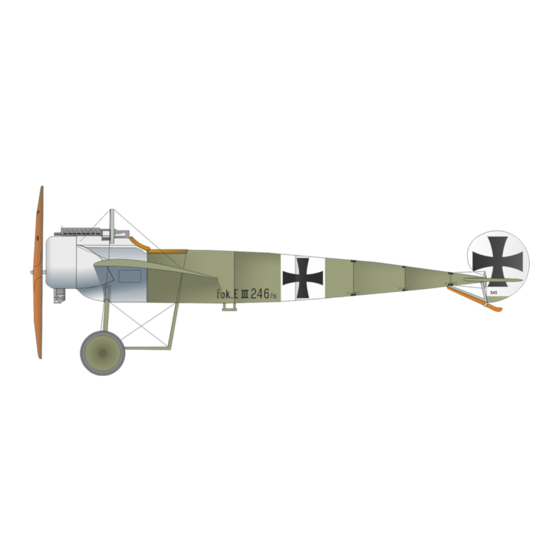
Werbung
Quicklinks
7444
1/72
intro
In early 1915 all of the air forces taking part in the battles over the western front,
solved the problem of how combat planes could be armed. The most effective offensive
armament was the forward firing machine-gun, however the problem was how to fire
forward through the rotating airscrew. The solution was accomplished differently
by various manufacturers and air forces. The French preferred firing through the
propeller circle with deflectors on the airscrew blades or a machine gun mounted on top
of the top wing to fire over the airscrew circle. The British developed a line of pusher
type fighters, amongst them the best known being the DH-2. The Germans were the
first to accept the most sophisticated system when Anthony Fokker, a Dutchman in
German service, designed and developed the synchronisation device. This device
interrupted the machine-gun fire when the airscrew was inside of the firing line. Fokker
mounted a synchronised machine gun to a type M5K single seat monoplane, which
he personally demonstrated in late May 1915 at the front line. The success was
complete, and the production of the Fokker E.I fighter was set-up immediately. Fokker
produced four types of fighter monoplanes in 1915. The E.III was developed in the
largest numbers, 300 Fokker E.IIIs and 115 other types( E.I, E.II and E.IV) were
produced. When these aircraft reached the front lines they brought in a new style of air
combat. Flown by enthusiastic pilots like Boelcke and Immelman, they changed fighter
aircraft into dangerous weapons and became a sign of german air superiority in late
1915 and early 1916.
úvodem
Na jaře roku 1915 řešila letectva států, bojujících ve světové válce, otázku výzbroje
bojových letadel. Jako nejefektivnější výzbroj se jevil vpřed střílející kulomet, tomuto
řešení ovšem bránila rotující vrtule. Různá letectva a jejich dodavatelé letadel
preferovali různá řešení tohoto problému. Francouzi upřednostňovali
montovaný na horní ploše horního křídla a přestřelující okruh vrtule, nebo střelbu
přímo skrz okruh vrtule s deflektory odrážejícími kulky od vrtule. Britové zavedli
do výzbroje řadu letadel s tlačným motorem a gondolou pro pilota a jeho kulomet.
Nejefektivnější a nejmodernější systém zavedli Němci, když Anthony Fokker,
Holanďan v německých službách, vyvinul synchronizační zařízení. Toto zařízení
zastavilo palbu kulometu v době, kdy vrtulový list procházel jeho palebným polem.
Fokker namontoval takto synchronizovaný kulomet na jednomístný jednoplošník M5K,
který na přelomu května a června 1915 osobně předváděl na frontě. Úspěch byl
okamžitý a úplný, následovala objednávka na dodávku těchto strojů německému
letectvu. Výroba se rozběhla okamžitě a dala celkem 415 kusů stíhacích
jednoplošných Fokkerů E.I až E.IV. nejrozšířenější z nich byl právě Fokker E.III,
vyrobený ve 300 kusech. Když se tyto stroje dostaly v létě a na podzim roku 1915
na frontu, přinesly s sebou významnou změnu ve vedení letecké války. Pilotovány
piloty zaujatými pro stíhací boj, jako byli Boelcke nebo Immelman, Fokkery změnily
stíhací letoun v nebezpečnou zbraň a staly se symboly převahy německého letectva
ve vzdušných bojích druhé poloviny roku 1915 a začátku roku 1916.
Fokker E.III
kulomet
7444 - NAV1
Werbung

Inhaltszusammenfassung für eduard Fokker E.III 7444
- Seite 1 Fokker E.III 7444 1/72 intro In early 1915 all of the air forces taking part in the battles over the western front, solved the problem of how combat planes could be armed. The most effective offensive armament was the forward firing machine-gun, however the problem was how to fire forward through the rotating airscrew.
-
Seite 2: Plastic Parts
PLASTIC PARTS A> 21 21 GUNZE Mr. METAL COLOR SILVER MC214 DARK IRON FLAT WHITE MC218 ALUMINIUM WOOD BROWN RED BROWN LIGHT GULL GRAY GRAY SAIL COLOR -Parts not for use. -Teile werden nicht verwendet. -Pieces a ne pas utiliser. -Tyto díly nepoužívejte při stavbě. - ATTENTION ACHTUNG ATTENTION... - Seite 3 decal 20 GRAY decal 21 GRAY MC218 ALUMINIUM SAIL COLOR GRAY decal 21 GRAY SAIL COLOR GRAY MC218 ALUMINIUM WOOD BROWN MC218 ALUMINIUM SAIL COLOR SAIL COLOR A1, A2...
- Seite 4 decal 19 WOOD BROVN SILVER MC218 ALUMINIUM GRAY MC214 MC214 DARK IRON DARK IRON MC218 ALUMINIUM MC218 ALUMINIUM...
- Seite 5 GRAY GRAY GRAY GRAY WOOD BROWN GRAY GRAY decal 18 decal 15 decal 14 WOOD BROWN MC214 DARK IRON decal 14 decal 15...
- Seite 7 British sources credit the crew of the FE.2b, made up of 2nd Lt. G.R. McCubbin (pilot) and Cpl. J.H. Waller (gunner). Fokker E.III 246/16 was covered in fabric with a grey-green shade, and the fuselage, wings and rudder carried later type crosses. ČESKOU VERZI TEXTU NALEZNETE NA www.eduard.cz POD KATALOGOVÝM ČÍSLEM 7444 WOOD...






